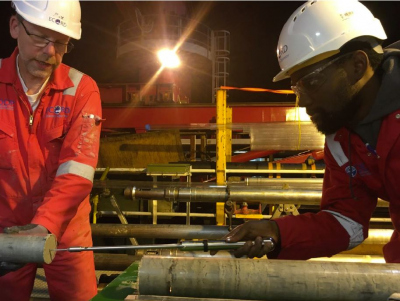- IODP at MARUM
- Partner to the ECORD Science Operator
- Exp. 381 Sampling and Measurement Plan
Exp. 381 Sampling and Measurement Plan

Offshore sampling and measurements plan
Owing to the nature of MSP expeditions, there is commonly limited laboratory space offshore, and as such there is no splitting of the cores at sea. The scientific analyses undertaken onboard are consequently limited to a subset of the expedition dataset. Offshore scientific activities include those essential for core curation, securing head space sediment samples and samples for pore-water chemistry, sampling for shipboard biostratigraphy, measurement of ephemeral properties including physical properties, and downhole logging.
This sampling and measurements plan is subject to amendment according to the scientific needs/interests of the Science Party and/or operational constraints. Routine measurements and core flow will be undertaken in line with the IODP-Mission Specific Platform (MSP) standard measurements procedures.
The following measurements will be carried out offshore:
Curation
A mobile core curation laboratory container will be on board the drilling platform. Curatorial representatives will have delegated responsibility in the absence of the ESO Curation and Laboratory Manager and IODP Curator for the Bremen Core Repository (BCR) and MSPs, Dr. Ursula Röhl. The cores will be curated and labelled, and stored in a temperature-controlled reefer (~4°C). There will be no splitting of the cores at sea with the majority of scientific analyses being conducted during the Onshore Science Party (OSP) in Bremen (scheduled to start 31st January 2018).
Core description
Prior to being stored in the temperature-controlled reefer, the cores will be described (through the liner) by members of the Science Party, and data will be recorded in the offshore Drilling Information System (ExpeditionDIS) database.
Core catcher (CC) samples will be collected on board at intervals dictated by the length of the core barrels used (1.5 m or 3 m). The core catcher will be described and sampled for initial sedimentological and micropaleontological analysis, and images of the CC will be taken.
If no core catcher sample is recovered, a sample from the lower end of each core will be taken for shipboard analysis. Thin section billets may be taken in representative sections for preparation in advance of the OSP, as advised by the offshore sedimentologists.
Geochemistry
Headspace sediment samples will be taken from the fresh cut end of a core section on a routine basis (in suitable lithologies and dependent on core recovery) and stored in the reefer container for onshore analysis.
In suitable lithologies, pore-water samples (e.g. squeezers and/or rhizone moisture samplers) will be taken on a routine basis. Pore-water will be extracted immediately from cores and ephemeral properties (e.g. salinity, pH, alkalinity and ammonia) will be analyzed. Sample splits for onshore analysis (e.g. cations, sulfide, 13C) will be prepared and preserved whilst offshore and stored in the reefer container.
It will be possible to take reference samples of the drill mud and the pump water if requested.
Core physical properties
Temperature-equilibrated cores will be measured on the drilling platform in a containerized laboratory utilizing a multi-sensor core logger (MSCL). The MSCL will collect gamma density, P-wave velocity (where acoustic coupling is possible), non-contact electrical resistivity, magnetic susceptibility and natural gamma radiation data. QA/QC checks will be carried out offshore, including regular measurement of calibration standards to monitor sensor precision and accuracy.
Small penetrometer devices will also be available offshore for acquisition of penetration resistance data: if appropriate and as requested.
Downhole logging
Super-slimline logging tools will be deployed to collect downhole logging data. In addition, downhole measurements of the in situ formation temperature will be acquired during coring operations for each hole.
The tool suite available for Expedition 381 includes spectral and total gamma ray, P-wave sonic velocity, S-wave sonic velocity, acoustic and optical borehole imaging, electrical resistivity, magnetic susceptibility, hydrogeological measurements (fluid conductivity, pH, eH, temperature, and dissolved oxygen), caliper and flow meter.
Spectral gamma ray, P-wave sonic, magnetic susceptibility and caliper have been identified as the priority measurements for this project.
The proposed downhole logging program consists of the following measurements:
• Through-pipe: spectral gamma ray (standalone).
• Open hole: dual laterolog (standalone); gamma ray + sonic + acoustic televiewer (stacked); gamma ray + caliper + magnetic susceptibility (stacked); spectral gamma ray; and/or conductivity + magnetic susceptibility depending on time and data quality from previous runs.
Other downhole logging measurements (to be acquired in open hole) will be included in the logging program depending on hole conditions, operational progress and preliminary scientific results.
Onshore sampling and measurements plan
The OSP will be undertaken at the IODP Bremen Core Repository (BCR) and laboratories at MARUM - Center for Marine Environmental Sciences, University of Bremen, and the Department of Geosciences, University of Bremen.
The following facilities will be available to the Science Party members during the OSP:
- Core splitting: the cores will be split into a working and an archive half in line with IODP procedures.
- Core description: ESO will provide IODP standard facilities for core description, including access to a CoreWall visualisation system. Core description will be undertaken on the archive half of the cores. For data entry, ESO will employ a version of the offshore Drilling Information System (DIS), called “ExpeditionDIS”, which is comparable with others being used in IODP.
- Digital line-scan imaging: high resolution images of the archive half of the cores will be acquired utilising an XRF-core scanner mounted with a line-scan camera.
- Thin section and smear slide preparation: as requested.
- Inorganic geochemistry: whole-rock and pore fluid chemistry; inductively coupled plasma–optical emission spectrometry (ICP-OES); ion chromatography (IC); energy dispersive X-ray fluorescence (ED XRF); and total carbon (TC) / total organic carbon (TOC) content (LECO CS analyzer) / carbonate content.
- Biostratigraphy: facilities to wash and sieve samples including controlled access to the HF lab at MARUM for palynology sample processing, microscopes including options for image capture.
- X-ray diffraction analysis (XRD): bulk mineralogy.
- Paleomagnetic measurements: natural remnant magnetism (NRM) with stepwise demagnetization (2G longcore cryogen magnetometer) or samples (robot system which feeds up to 100 adapted sample cubes).
- Physical properties measurements:
- Thermal conductivity on whole cores will be acquired by ESO staff prior to the OSP at MARUM utilising a needle probe system. Additional standard IODP physical properties measurements may be undertaken on whole cores at this time in the event offshore datasets are incomplete. This may be owing to time (natural gamma radiation) or permitting issues (gamma density).
- Physical properties of discrete samples: P-wave velocity and moisture and density properties (MAD) including: wet bulk density; grain density; porosity; and void ratio. For MAD measurements, core samples will be oven-dried (60° ± 5°C), the dried sample volume will then be quantified using a Quantachrome penta-pycnometer with sample masses being measured using a high-precision balance.
- Undrained shear strength (Su): measurements utilizing a torvane, pocket penetrometer, and/or fall cone (on request) can be undertaken on the working half of the core.
- Color reflectance: measurements acquired using a MSCL mounted with a Minolta spectrophotometer.
- Core sampling: A detailed sampling plan will be devised following review of all revised sample requests by the Sample Allocation Committee (SAC), prior to the start of the OSP and after the scientists have submitted their revised sample requests.


